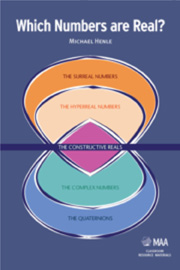2 - Construction of the Reals
from I - THE REALS
Summary
Why construct the reals?
We will prove the existence of the real numbers two times—by twice constructing a complete, linearly ordered field. Afterwards, we prove that all complete, linearly ordered fields are isomorphic, meaning that our axiom system for the reals is categorical.
The reader might well object to this chapter in the following terms: “I've used the reals all my life; their properties are familiar; I know how to calculate with them; I know the calculus; I know everything. Why should I bother to construct the reals, when I know the result in advance?”
How do we know the reals exist? Just because we've used a few of them over the years and assumed some properties for them does not allow us to conclude that they are really out there. Physicists argued for years about properties of the æther before it was discovered that it doesn't exist. To avoid a similar fate the reals' existence must be proved. The simplest and most reliable way to do this is to construct them.
It was empirical evidence (the Michelson-Morley experiment, 1887) that did the æther in. The reader might argue that generations of mathematicians, scientists, and engineers have used the reals without encountering any problems: doesn't that constitute experimental evidence for the existence of the reals? Certainly it does, but the goal of mathematics is to construct theories backed by stronger evidence than experiment. Experimental evidence only makes the existence of the reals plausible. It is possible, despite years of use, that the axioms of the reals contain a hidden inconsistency.
- Type
- Chapter
- Information
- Which Numbers are Real? , pp. 35 - 54Publisher: Mathematical Association of AmericaPrint publication year: 2012



